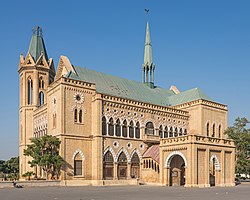
Sindh is a province in Pakistan.
The province includes a number of important historical sites. The Indus Valley civilization (IVC) was a Bronze Age civilization (mature period 2600–1900 BC) which was centred mostly in the Sindh. [1] Sindh has numerous tourist sites with the most prominent being the ruins of Mohenjo-daro near the city of Larkana. [1] Islamic architecture is quite prominent as well as colonial and post-partition sites. Natural sites, like Manchar Lake have increasingly been a source of sustainable tourism in the province. [2]




